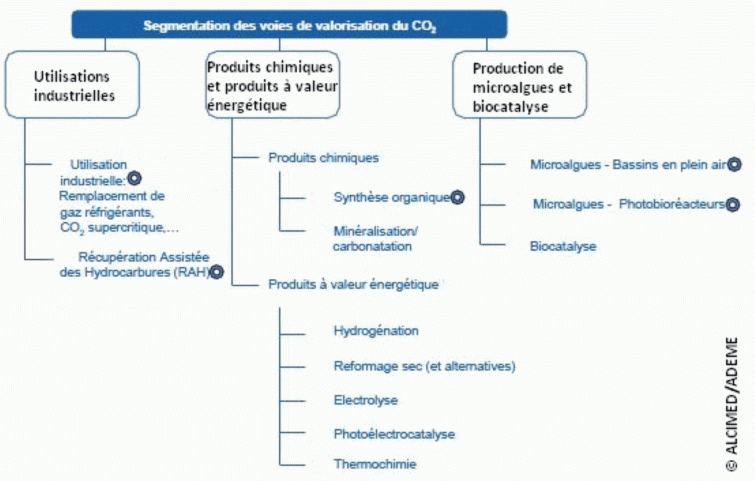Since 1980, many studies focused on the potential of CO2 to be reused: once captured, why not apply it to other industries which already consume CO2 or its derivatives, or find new uses for it ?
Concept
The idea of reusing CO2 is to make profit in exploiting it as primary resource. It still has to be captured and extracted from industrial smokes, but instead of being stored underground it will be re-used in new chemical, industrial or biological applications.
CO2 reuse does not replace storage, as depending on the applications it could eventually return into the atmosphere after it has been used. The interest of this field lies in the fact that the CO2 that is used is one that has already been captured, thus preventing more production of CO2 for applications that specifically need it.

Since 1980, many studies focused on the potential of CO2 to be reused: once captured, why not apply it to other industries which already consume CO2 or its derivatives, or find new uses for it ?
Concept
The idea of reusing CO2 is to make profit in exploiting it as primary resource. It still has to be captured and extracted from industrial smokes, but instead of being stored underground it will be re-used in new chemical, industrial or biological applications.
CO2 reuse does not replace storage, as depending on the applications it could eventually return into the atmosphere after it has been used. The interest of this field lies in the fact that the CO2 that is used is one that has already been captured, thus preventing more production of CO2 for applications that specifically need it.

Caption: segmentation of the ways to reuse CO2
These methods for reusing CO2 are not all at the same development stage: applications of an industrial level already exist for some, whilst for others the potential for industrial emergence varies between 5 and 20 years.
The ways of reusing CO2 are plentiful and they do not all have the same financial of technological characteristics: there are several obstacles related to the energy consumed for the processes of reuse, the potential volume of CO2 that can eventually be reused, the extent of time during which the CO2 can be trapped, and the possible effects of these processes on environment and health.
What scale?
The field of CO2 reuse exists since 1980, but in 2008 still represented only 0.5% of world Anthropogenic CO2 emissions
Although it is difficult to assess the market of CO2 reuse precisely, the classic industrial utilization of CO2 was estimated to 153.5Mton worldwide (40Mton of which for enhanced hydrocarbon recovery) in 2008, which represents 0.5% of yearly global emissions. The main challenge in reducing CO2 emissions by reusing it consists in finding new applications beyond the 153Mton reused today; particularly via new technologies which could develop into bigger scale processes whilst ensuring they remain profitable and positive for the environment.
For instance, synthesizing energy products could ultimately use 5 to 10% of world emissions, i.e. between 1.5 and 3Gt of CO2 – ten times more than the amount of CO2 currently used.

Caption: world usage of CO2
The countries most advanced in the field of CO2 reuse are the United States and Japan, who initiated leading pilot projects for the production of synthetic fuels using CO2. The first European and French projects appeared at the beginning of the 2000s. The scientific community now tends to communicate evermore on the potential for CO2 reuse under its various forms, and it is a field that is expected to continue to develop in the next years.



